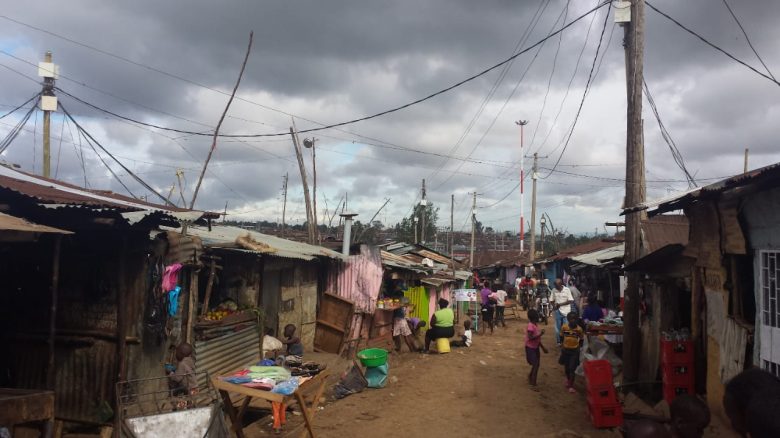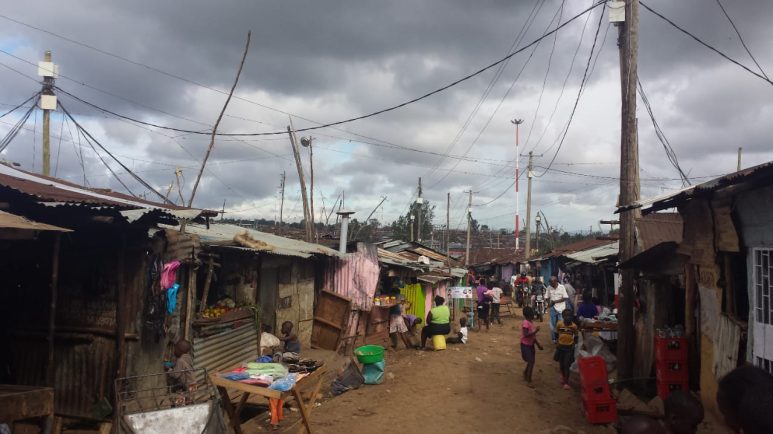By Joseph Maina
George Ogaga, a resident of Kibera slums in the Kenyan capital, watched with bemused indignation as anti-government protests heated up in Nairobi in July. The media was awash with gory details of the protests, and the overall narrative depicted one massive orgy of violence, mayhem and destruction.
Slogan-chanting youth had engaged anti-riot police in violent confrontations. There were scenes of tyres smouldering on some roads, with rocks strewn all over and teargas fumes billowing in the horizon.

But what confounded Ogaga was how the coverage of the protests, which he had witnessed first-hand, missed a number of crucial details and ended up casting his neighbourhood in negative light – as usual.
“Everybody was made to believe that Kibera was one sprawl of chaos and mayhem. That was simply not true. There were parts that didn’t witness the protests, but we’re all made to look bad. The media should have been specific about where the protests took place,” he said.
Overall, the media’s coverage of Kibera slums has seen the sprawling shanty town earning the unflattering distinction as the nation’s violence hotspot and the headquarters of sleaze, filth and every imaginable vice.
Ogaga insists that the hidden hand of politicians financing and fuelling the chaos has been missing in media narratives touching on the Kibera demos. To illustrate, he recalls an incident in May 2023 when rowdy youth torched a bus along Ngong Road, which passes near the shanty town. This brazen hooliganism, he said, was again blamed on Kibera protestors.
“Kibera is generally peaceful. We’ve however seen goons being shipped into the region to cause mayhem. In one of the recent protests, I could see that a good number of the protestors were not Kibera residents. Quite many of the rowdy youths you see on TV confronting the police are not Kibera people,” he told MDI.
He adds that in some cases, criminals are often paraded as Kibera residents when in fact they are not. “Like the case of that bus, we strongly believe that this fire was not started by Kibera people. You recall the former governor of Nairobi admitted publicly in 2021 that he and accomplices used to buy second-hand vehicles and hire goons to torch them, which would later be blamed on the opposition. The bus incident reeks of similar machinations. We could see, for instance, that the bus didn’t have a registration plate. We later determined that the bus had earlier on been put up for sale, which seemed to prove our theory. But the media never came this far and simply reported that Kibera protestors had torched a bus on the highway.”
Nicholas Otunga, who vied for an elective post in Kibera during the 2022 general elections but lost, agrees with this overall judgement. He said the settlement’s bleak image is the result of manoeuvrings by the political elite, with the media falling headlong into the trap.
“Kibera people are generally peace-loving and harmless. If these were evil people as painted in the media, I wouldn’t be living here. I know there are challenges that include poverty and joblessness, and I also understand that we have some bad characters among us, but by and large these are peaceable people,” he said, adding that mayhem is largely executed by hired gangs brought in from other areas. “If the media took time to investigate who among the demonstrators shot by the police was actually from Kibera, the narrative would change.”
To be fair, some media reports succinctly acknowledged that the demonstrations were rife only in parts of Kibera, with business was going on as normal in most parts of the vast slum.
“There are two specific hotspots, even for these anti-government protests,” Rose Otiato, a Kibera youth leader who was born and brought up in the slums, told MDI. “Looking at the media’s coverage, one would think the entire Kibera is up in flames, but that’s not the case. The demos majorly happen at the bypass area and Gatwekera zone within Kibera.”
She affirmed that some of the youths were alien to the slums. “We would look at some of the casualties and it would emerge that they were from Kawangware, Mathare, Korogocho and other areas of the city, mixed with some of our own youths. We know this because some of the youths in these demos and political rallies have even been known to ask around for directions, meaning they were newcomers.”
Rose even swears that in one of the photos from the infamous post-election violence of 2008, where protestors ganged up to uproot the railway passing through the slums, she can pick out someone whom she knew very well was from the Dandora area of Nairobi. Dandora is well over 20 kilometres away, in the other side of the city! “I usually point at that man in the photo and tell everyone, look, this is a person I know very well. He was not from Kibera, yet everybody says Kibera people uprooted the railway,” Rose said. In any case, Nicholas states that the railway was uprooted by a group of disgruntled people and the entire Kibera needn’t be lumped into the blame for the incident.
Both Nicholas and Rose agreed that the media has largely been failing the test of diligence when reporting on Kibera and have been particularly rash to cast the area in the usual negative light.
“I wish the media would listen when some of us point out that a particular person killed in the confrontations is not native to Kibera. But they never listen to us. They just go ahead and publish or broadcast that a Kibera resident has been killed,” Rose said.
She tied this pattern to a disturbing development during the height of the COVID-19 pandemic, when various restrictions were imposed on the country and every death from the disease made sensational headlines. “At one time, it was reported that six people from Kibera had died of COVID-19. We were dumbfounded and curious. Which Kibera was this? Personally, I hadn’t even seen an ambulance in my area.”
She believes that due to its tainted past, Kibera suffers bad press especially in the hands of journalists who don’t go an extra mile to verify the facts. Rose feels that the media simply regurgitates the figures given by politicians and the authorities. In one of the more dramatic episodes during the 2023 anti-government protests, police shot a man in the leg in what was widely said to be Kibera. “Looking at the background of the photo, we could tell that this happened in Mathare slums and not Kibera. But the information went out there that the incident happened in Kibera,” Rose said.
Kibera has also been cast as the home of flying toilets, due to poor sanitation. George, Rose and Nicholas concede that this was the case in the past – a time when human waste would be stacked in polythene bags and tossed into the night – but those days are long gone. George recalls those perilous nights, having once came face to face with the cargo – quite literally – in the dead of night. “There weren’t many toilets, which made every toilet a luxury in its own right. People feared Kibera. Things are different now, and we have plenty of toilets including those built by the government through the National Youth Service,” he said.
Muggings and robberies were equally rife, but this has largely changed, said the three. But conspicuously missing in media reports about Kibera, has been the corresponding efforts to upscale the living standards of the residents as a way to stem the poverty and vices tainting the slum’s image. “The Kibera of today is not the Kibera I lived in as a little girl,” Rose said. “We’ve seen numerous development projects with far reaching impacts, but these hardly command media attention. Toilets and sewer lines were constructed, and people were warned against putting up buildings without toilets. There are many, better roads now, and drainage has been improved in many areas. Many jobless youths have ventured abroad to work and others were employed by various government and NGO programs, and there are street lights all over. All this has seen muggings and general crime plummet. The debacle of Kibera’s dangerous alleys, filth and flying toilets is history, but nobody wants to highlight this growth,” she said.
The solution?
Rose said the solution lies in fostering a diligent media that goes behind the scenes, one that overcomes the stereotypes associated with the slums. The media must also invest in second-day journalism. “There must be journalists coming back the following day and asking the follow-up questions. There is need for investigative journalism to establish the facts. For example, journalists must follow the casualties in hospital to determine who exactly these people are and where they come from.”
George further prescribes local media outlets preferably run by Kibera residents and citizen journalism as two ways to help panel-beat the dented image of the slum in the news. There has been too much parachute journalism, he said. Though there have been a few homegrown media startups, George feels they are still fledgling attempts that haven’t had much impact, despite showing promise.
Nicholas suggested that the media also needs to detach itself from the narratives spun or staged by the political class and seek its own independent coverage devoid of nuances depicting the region negatively. The media is simply not doing enough, and this hurts the image of Kenya’s largest slum.

